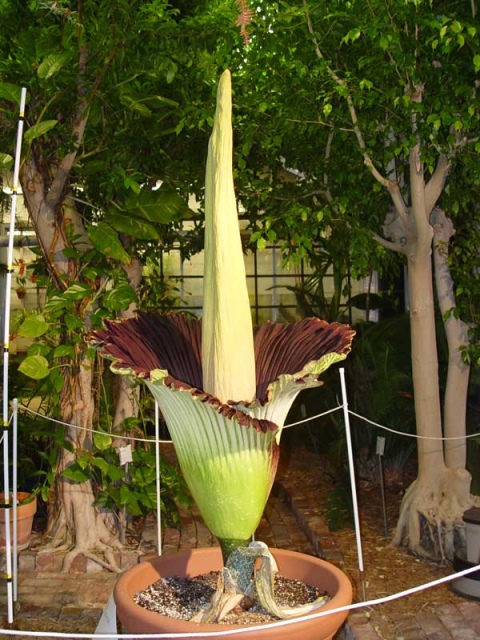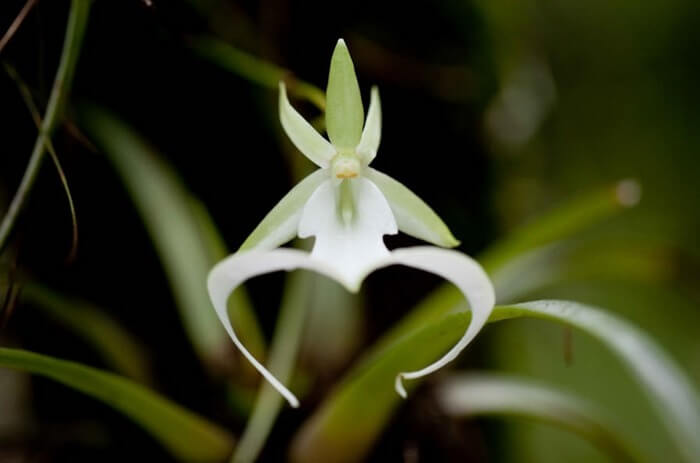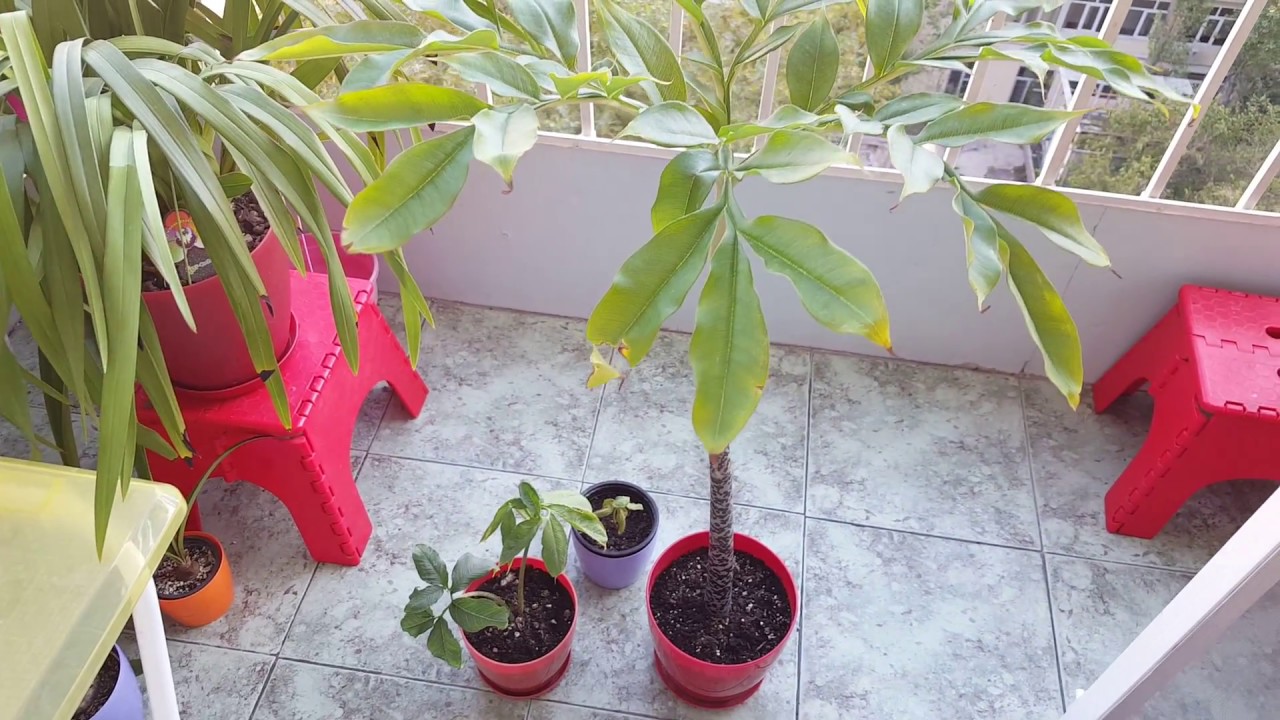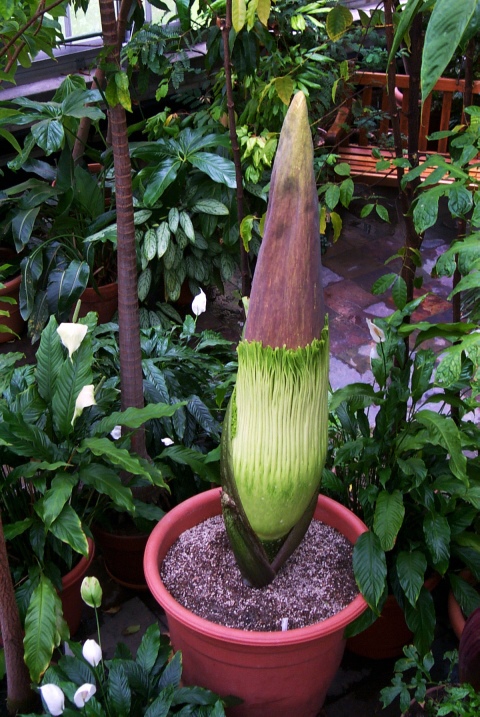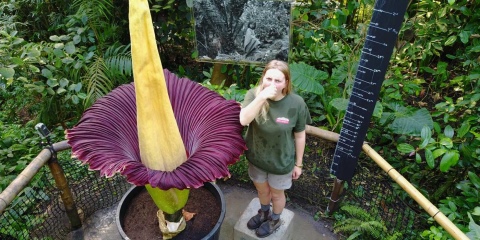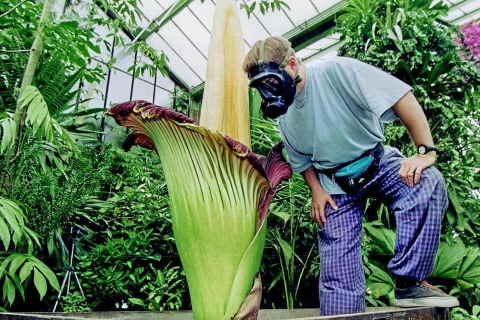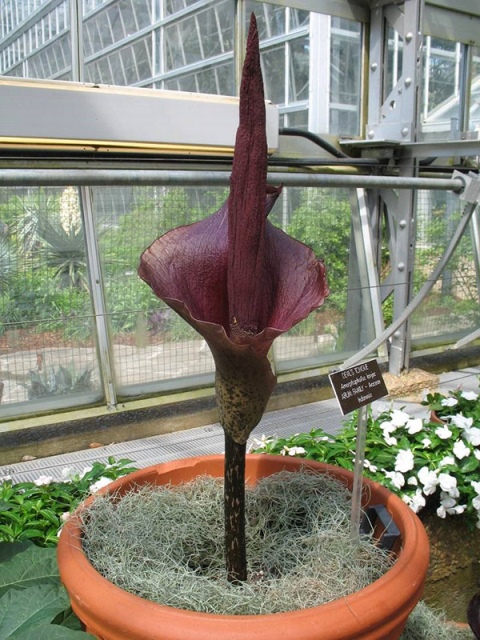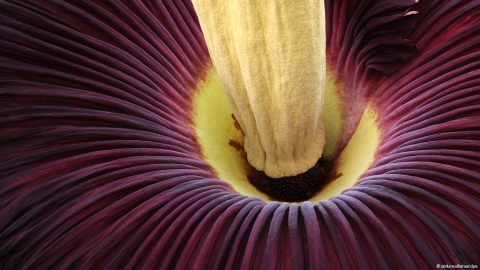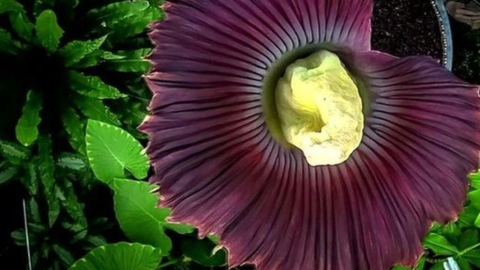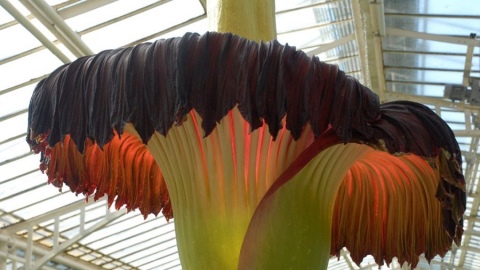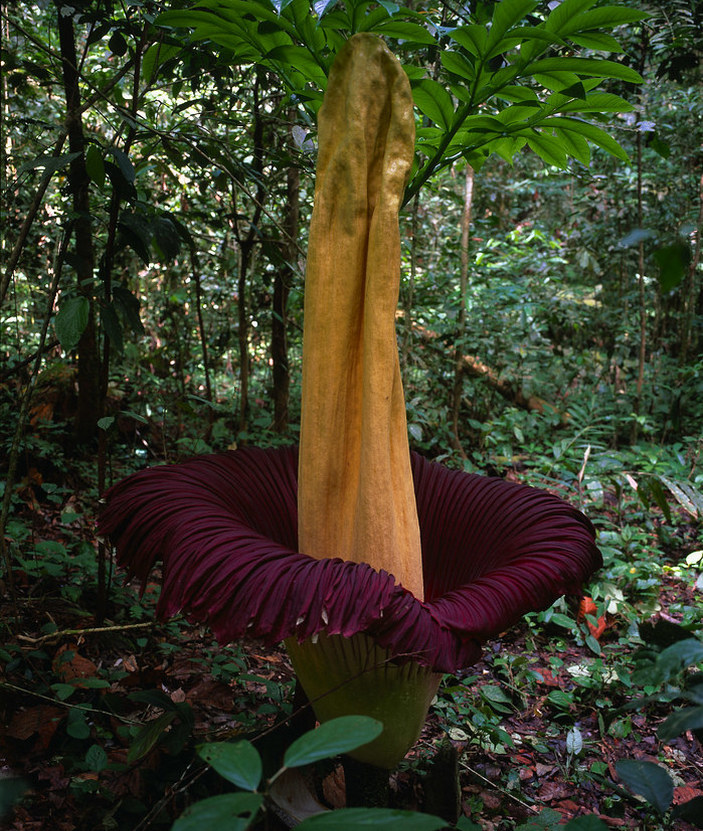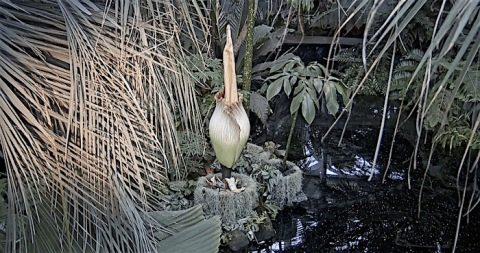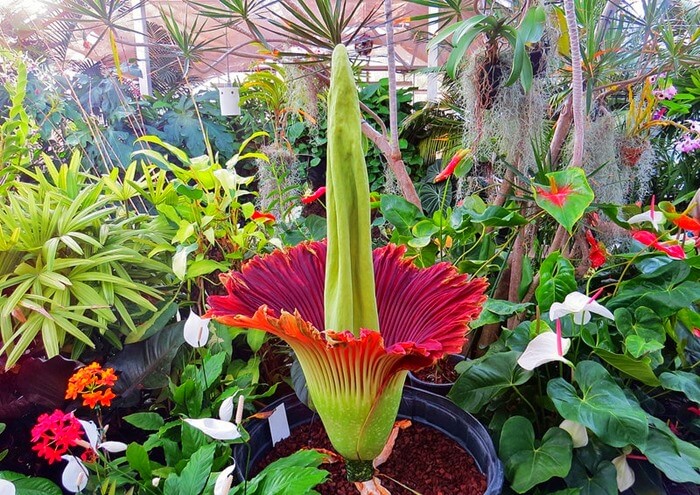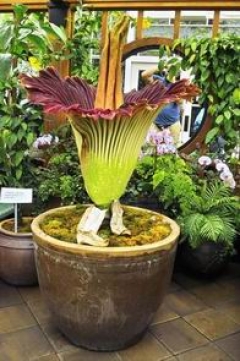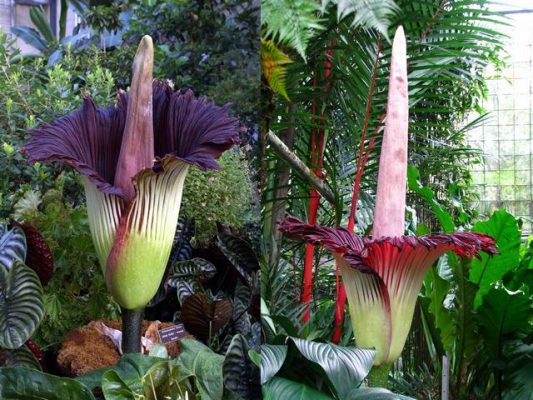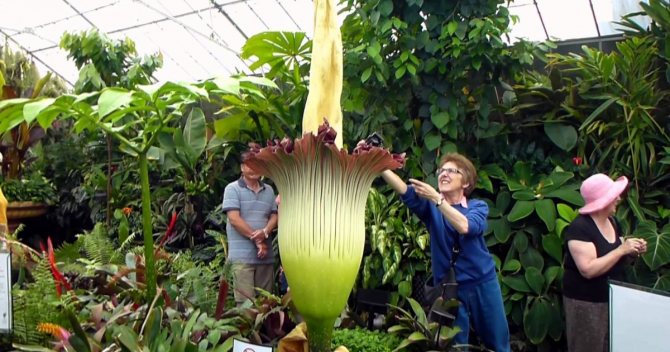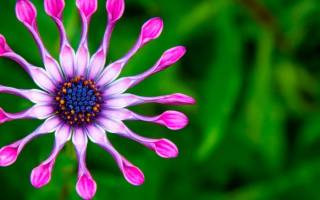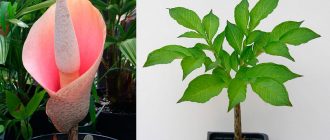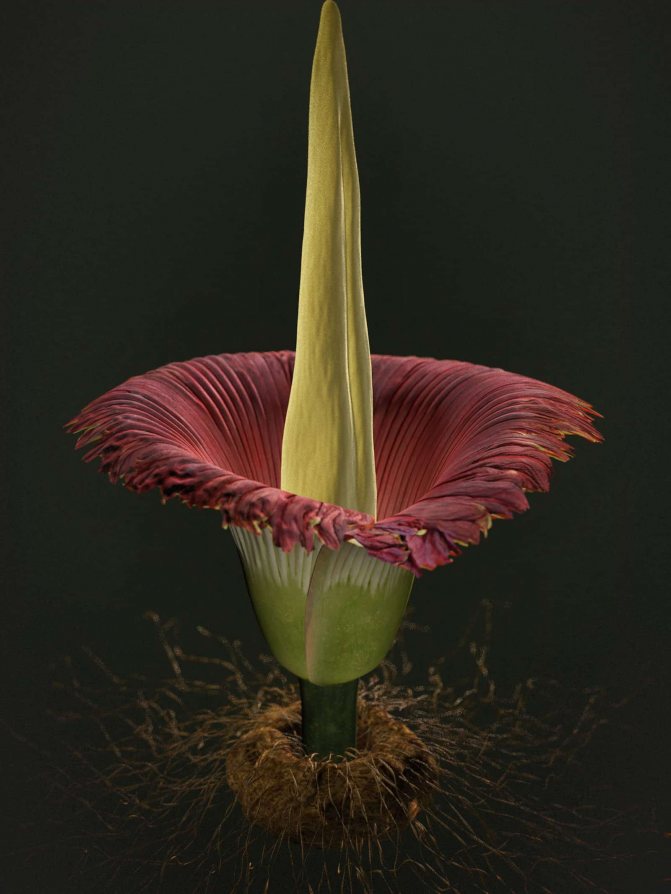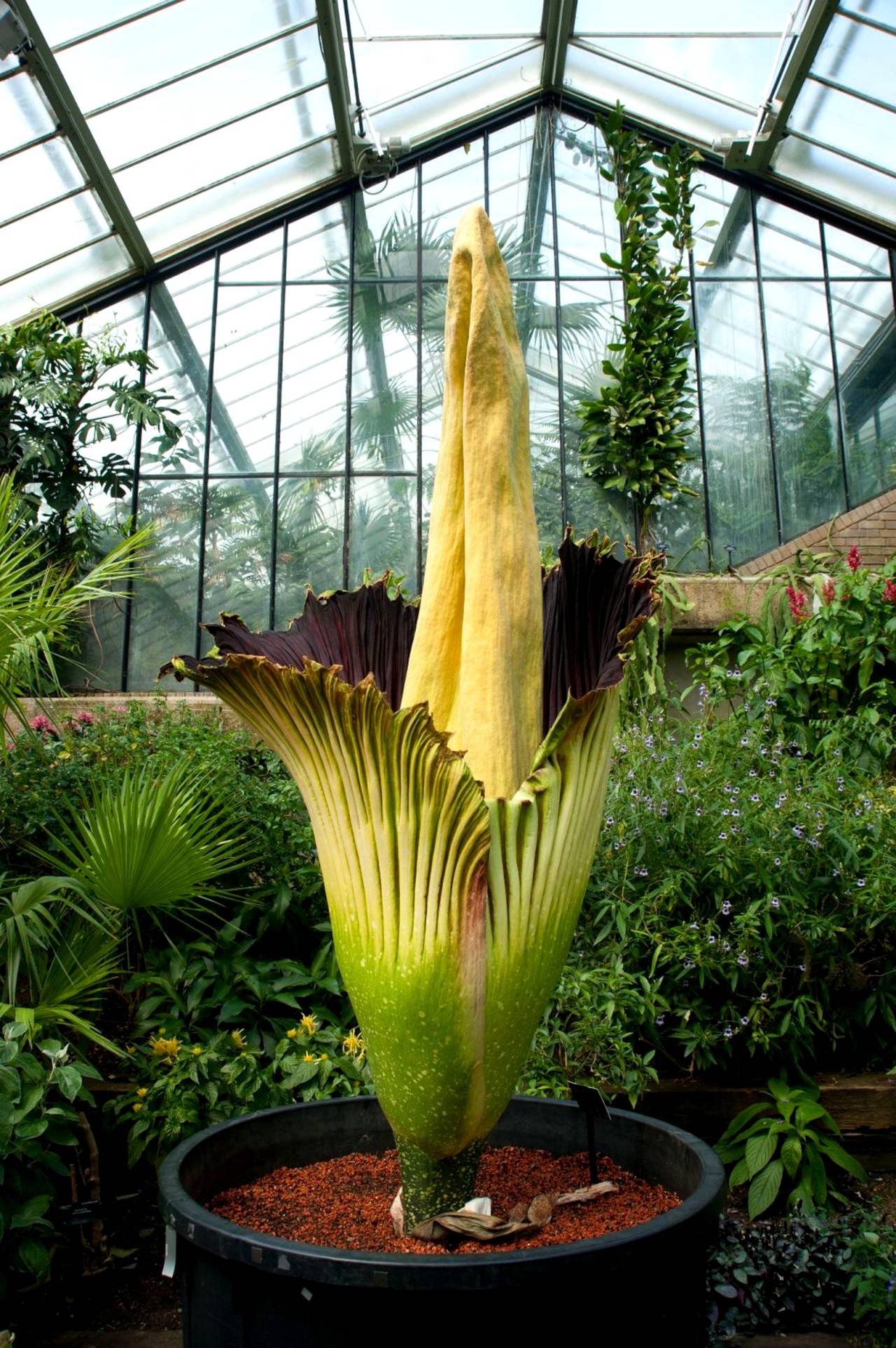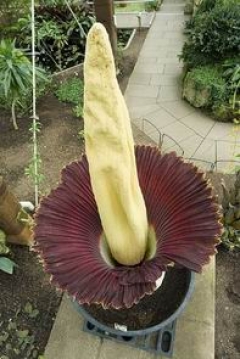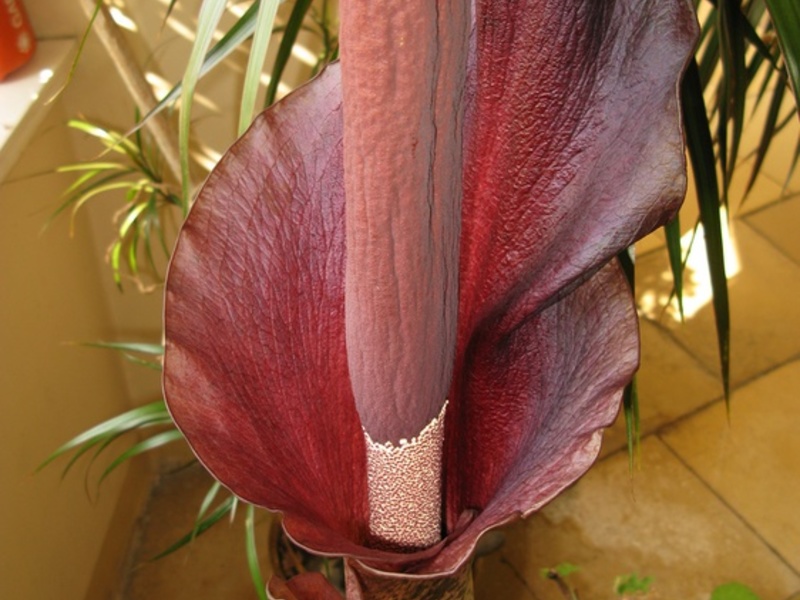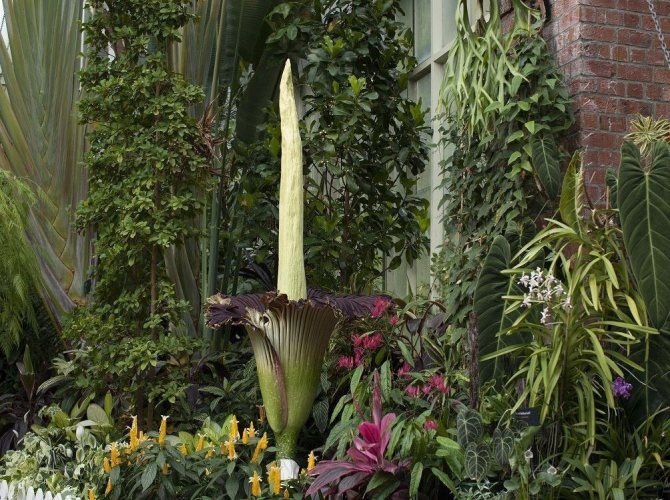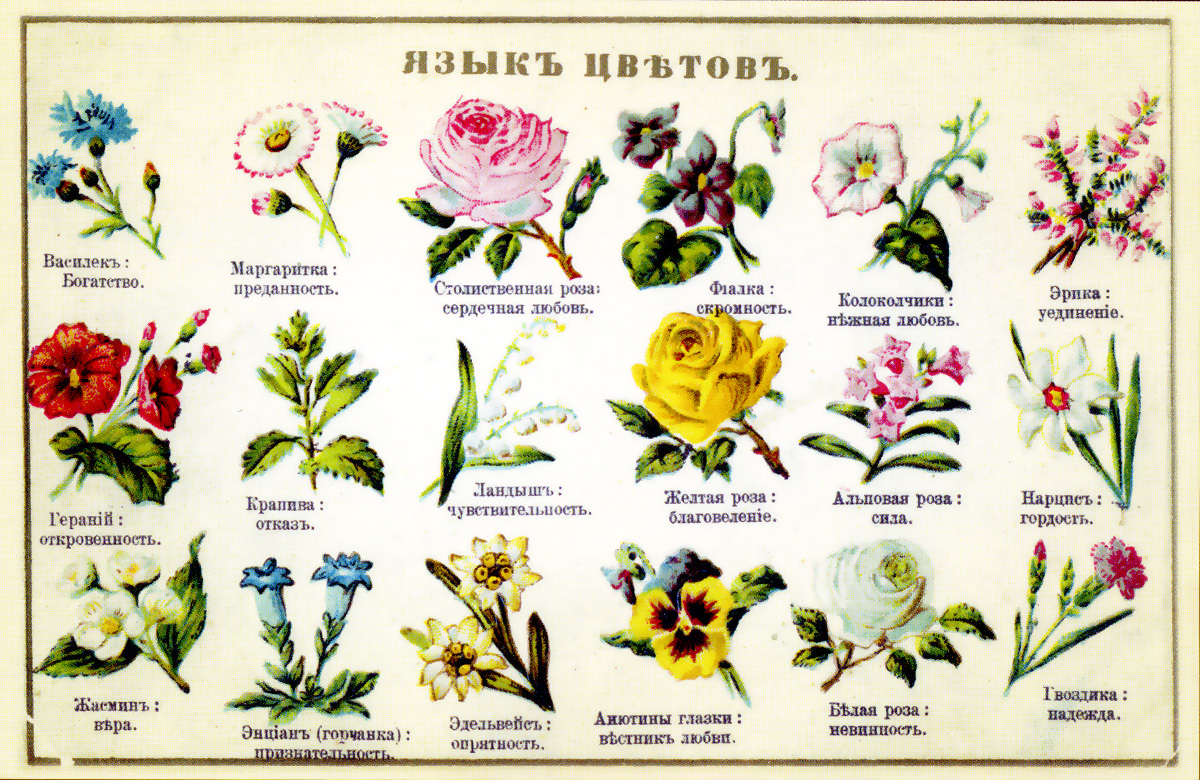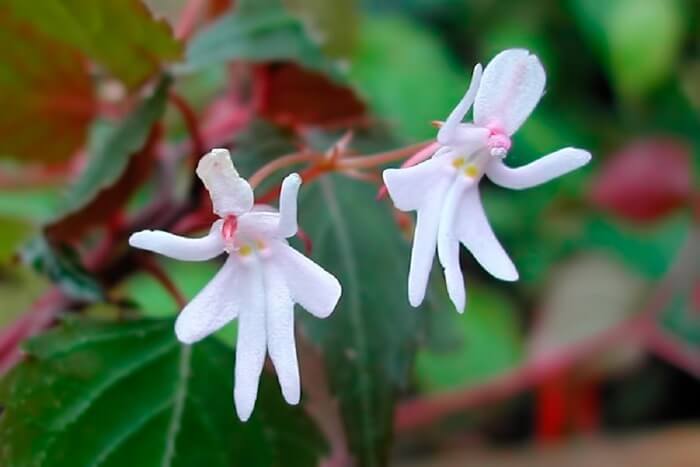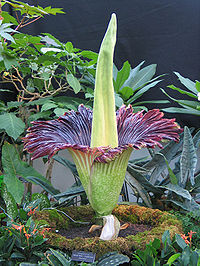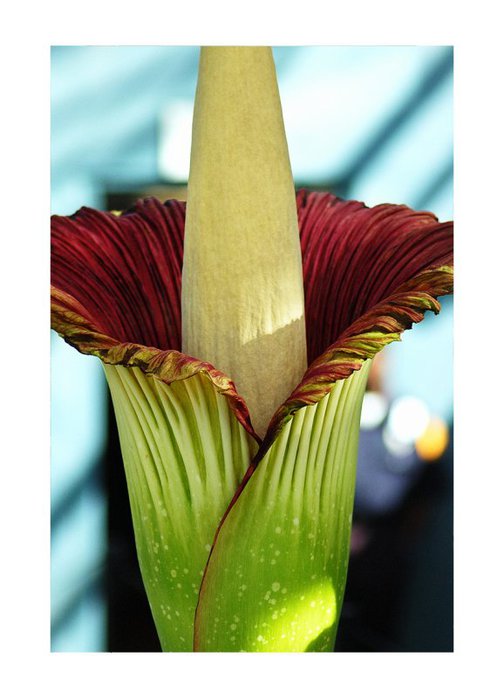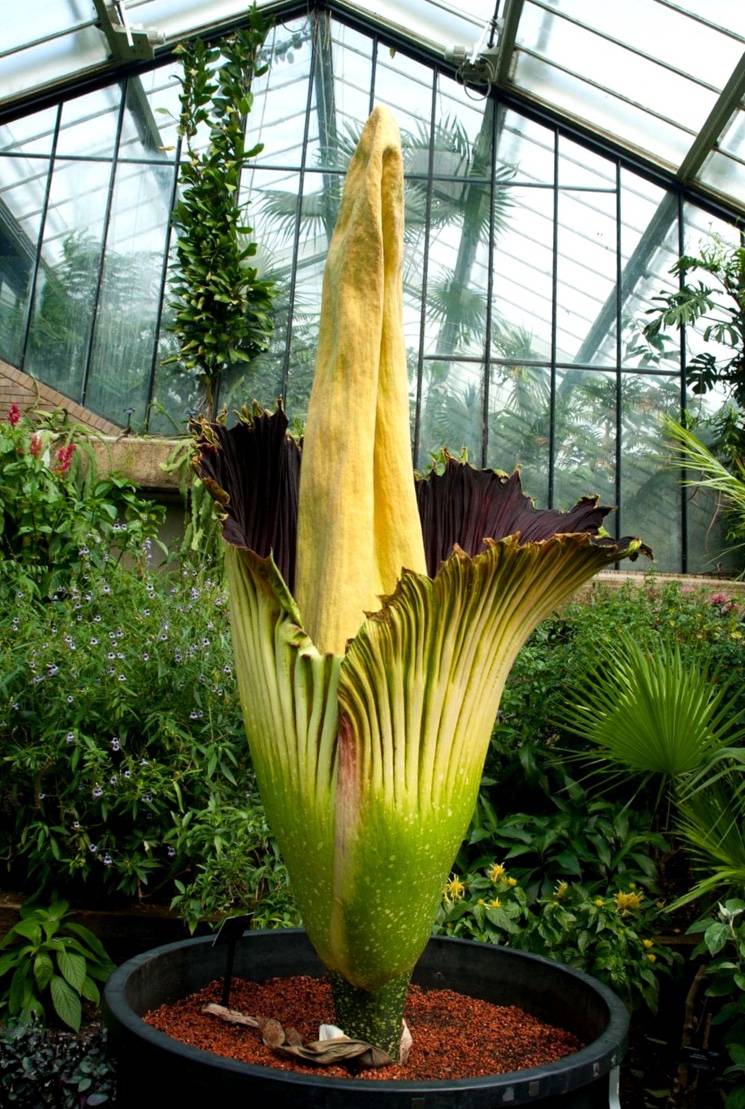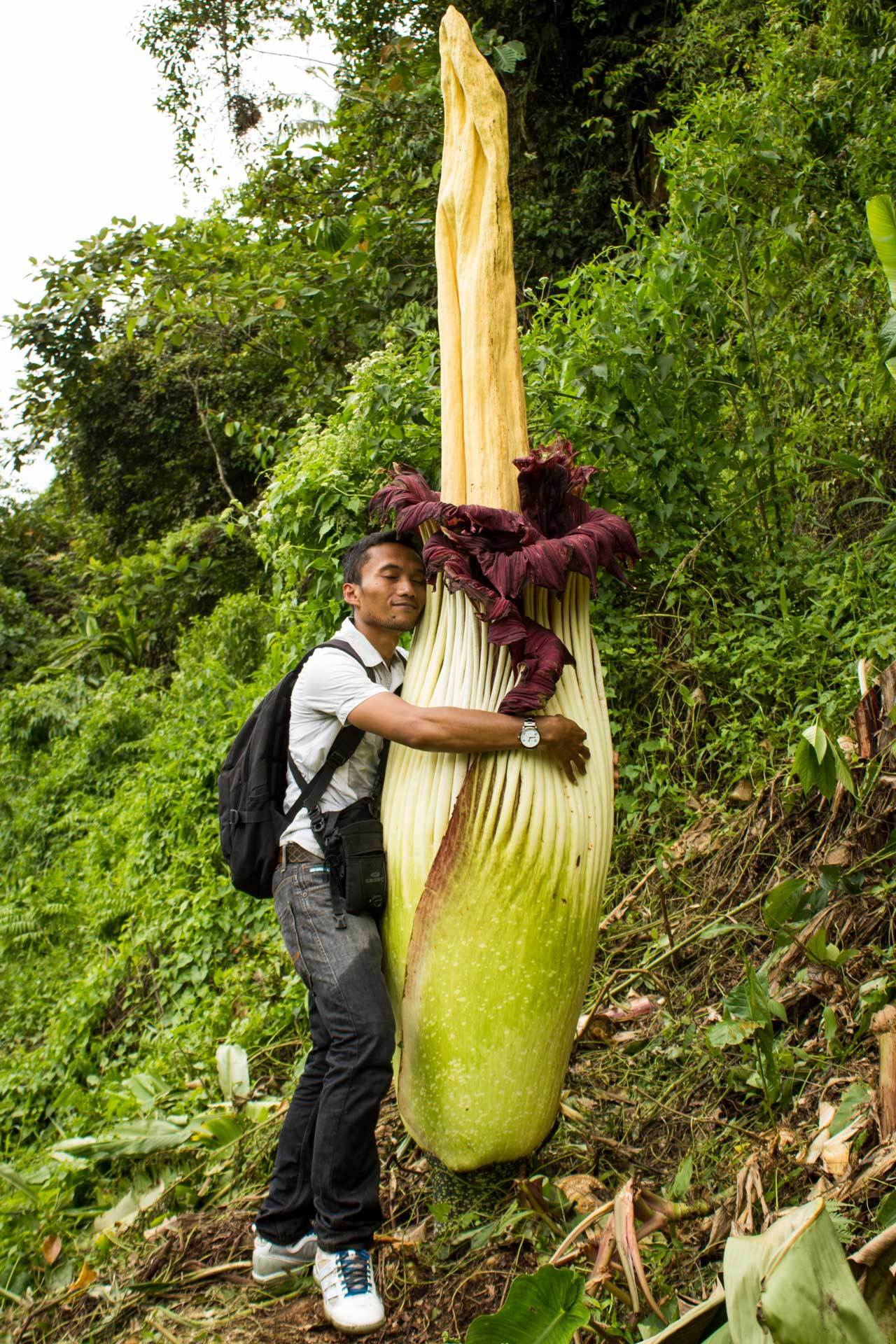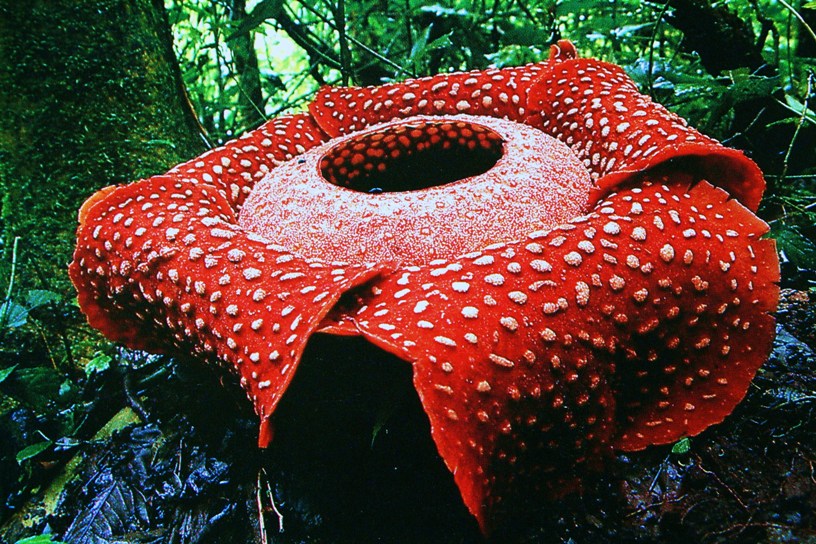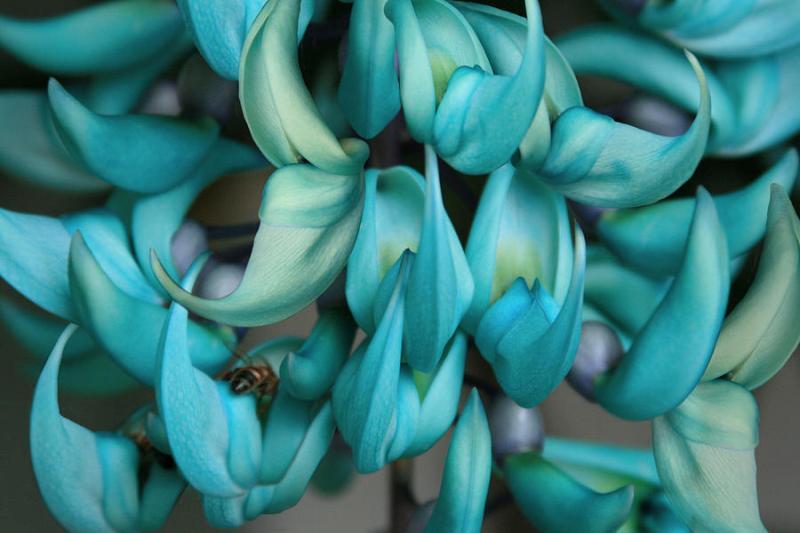Features of room content
Amorphophallus is easy to grow indoors. It does not have any special requirements for the content - warmth during the growing season, bright diffused light and slightly increased air humidity.
Cognac
Amorphophallus cognac is a perennial plant grown from a tuber, also often found under the name Amorphophallus rivieri (river). In China, Japan and some other countries it is grown as an edible plant. Various dishes are prepared from dried and chopped tubers - soups, side dishes and seasonings. Due to its ability to lower blood sugar and cholesterol, it is used in dietary nutrition for various gastrointestinal diseases and obesity.
The inflorescence of amorphophallus cognac consists of a long cob of burgundy-purple color, framed by a petal-veil. Female and male flowers form in the lower part of the peduncle, while the crown remains sterile. When grown in a pot, the inflorescence often reaches a height of 80 cm. The green leaf that appears after flowering is strongly dissected, with many small pointed leaf segments attached to a hollow petiole, resembles an umbrella in shape. Every autumn, the leaf dies off, and after a period of dormancy, a new one grows - a little higher than the previous one and more dissected. In indoor conditions, the height of the leaf and the diameter of the crown usually do not exceed one meter.
The amorphophallus tuber cognac is flattened, rather large, 20–30 cm in diameter, growing many roots in the upper part. The plant reproduces easily with the help of the children that form on the tuber.
The flowering of amorphophallus cognac lasts two weeks, usually in March-April, closer to summer a leaf appears. The plant goes through all stages of development in six months and in September, after the death of the leaf, goes into a state of dormancy.
Bulbous
Amorphophallus bulbiferous does not bear fruit when kept indoors. The inflorescence consists of a cob about 30 cm long and a pink-colored petal, sometimes with green blotches. The ear does not rise above the veil. The leaf is bright green, strongly dissected, with a hollow petiole. The color of the petiole is very interesting, reminiscent of camouflage - light, with gray-green spots. Amorphophallus bulbiferous reproduces with the help of bulbs that form by autumn at the base of the leaf. Otherwise, the timing of flowering, development and dormancy for pot cultivation are the same as for amorphophallus cognac.
Titanium
Amorphophallus titanic due to its gigantic size is grown mainly in greenhouses. In nature, it practically disappeared, and only in 1993 one of the expeditions to Sumatra managed to find this plant and collect seeds from it. Today, all titanic amorphophallus found in greenhouses are grown from those seeds or have already been propagated.
Blooming amorphophallus titanic is an unforgettable sight. The flower can reach 3.5 meters in height and weigh over 70 kg. The ear rises above the veil and consists of many flowers collected at the bottom. The ruffled bedspread is greenish on the outside and bright burgundy on the inside, reminiscent of an inverted luxurious skirt. The crown of the cob during flowering heats up to 40 degrees, which contributes to the better spread of the eerie odor, thereby attracting pollinators. The inflorescence ripens within a month, then opens sharply and remains in this state for only one night. Therefore, the bloom of the titanic amorphophallus becomes an event for amateurs - each flower is measured, weighed, assigned names, and the measurement results are entered into historical records.
4–5 days after the beginning of flowering, the top of the ear is destroyed, and on the lower part, if pollination has taken place, berries are tied. When ripe, they turn bright orange and reach the size of a cherry.
Peony-leaved
Amorphophallus pion-leaved outwardly is very similar to titanic, differs only in more modest size. Strongly dissected single leaf about one meter long, pimply petioles with spots grow up to two meters. The inflorescence consists of a creamy cob about 70 cm high and a corrugated blanket, green on the outside and red-brown on the inside. The development of the peduncle, leaf and tubers is no different from the vegetation of the amorphophallus cognac.
Amorphophallus paeoniifolius (Amorphophallus paeoniifolius)
Amorphallus cognac is not the only ornamental and food plant in the genus. In some provinces of China, in Vietnam and on the islands of the Pacific Ocean, amorphophallus pion-leaved, called elephant yam, grows.
With the general similarity of the tuber and leaf, the inflorescence and veil are very different in appearance from Konniaku and Arum Titanum. The purple or violet-greenish bedspread has a pronounced frill along the edge, and the upper part of the cob held on a shortened petiole resembles the fruiting body of a strongly overgrown line.
The tuber of an adult amorphophallus pion-leaved can weigh up to 15 kg and reach 40 cm in diameter. At home, this species is cultivated as a food, medicinal and forage plant. They use flour obtained from tubers and the corms themselves, which are fried and boiled like potatoes.
Like the lower part of the bedspread, the leaf petiole has a mottled color. The leaves of this species really resemble the foliage of a famous garden flower, but unlike it, they can grow from 50 to 300 cm in diameter.
Main characteristics and photos of amorphophallus
The humid tropics of China and India are considered the homeland of this flower, but various species can be found in tropical and subtropical regions of Africa, Asia, Australia and many Pacific islands.
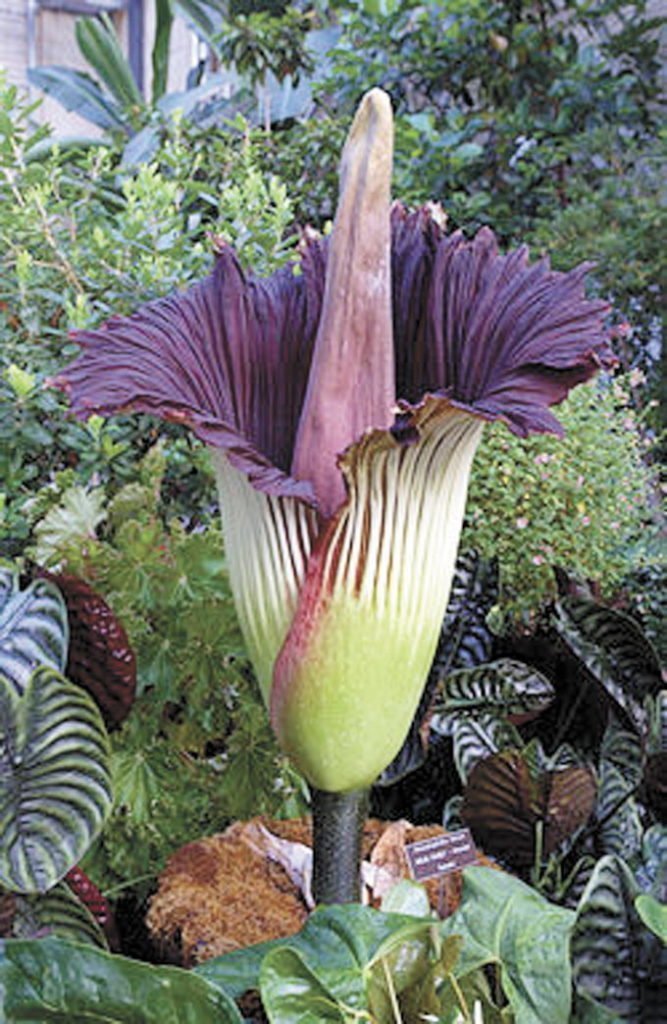
From Greek amorpho translates as formless, phallus - phallus
Amorphophallus (Amorphophallus) is a deciduous plant of the aroid family. From Greek amorpho is translated as formless, phallus - phallus. The plant belongs to ephemeroids - long dormant. In a short growing season, amorphophallus manages to bloom, grow leaves, shed them and go to rest. Apparently, due to this quality, as well as the fact that the blossoming flower exudes a very unpleasant smell of spoiled meat, this plant is not particularly popular with flower growers.

In a short growing season, amorphophallus manages to bloom, grow leaves, shed them and go to rest
Flower development phases
The genus amorphophallus has about a hundred species of plants, very different in size, with peduncles from 30 cm to 5 meters. These plants develop from tubers similar to beets, weighing up to 90 kg in some species. For about six months, the tuber is dormant. The aerial part of the plant consists of a single thick shoot, on which a powerful, strongly dissected leaf develops, and the flower becomes like a palm tree. Indoors, the leaf unfolds most often in April. In this state, amorphophallus remains until October, then the shoot turns yellow and dies, and the plant begins a dormant period. In the spring of next year, a new leaf will appear, larger and higher than the previous one and with a more dissected leaf plate.

It's hard to believe that this tree is an amorphophallus leaf
Amorphophallus blooms after awakening and before the leaf appears. Flowering is short, usually about two weeks. At this time, the tuber greatly decreases in size, spending the reserves of nutrients for the development of the flower. After the end of flowering, a short-term dormant period begins. Within three to four weeks, the plant recovers and releases another leaf.
If pollination occurs during flowering, then fleshy fruits with seeds will appear in the lower part of the ear of the amorphophallus. After the fruit ripens, the plant dies. With indoor cultivation, pollination is very difficult to achieve - for this, at least two plants of the same species must bloom at the same time.
Care principles
Growing this plant on your own is very difficult. In most cases, the flower is acquired in the dormant stage, when its leaves turn yellow and fall off. During this period, indoor plant lovers think that the flower has died and buy a new one. In this regard, it must be remembered that the growing season of rest of the flower is 6 months. As soon as this period passes, the culture gives new leaves and departs from the vegetative period.
The plant is not very demanding for watering. Amorphophallus titanic is watered during active development, once a week. For these purposes, it is good to use a spray bottle. During dormancy, watering is reduced to a minimum. The bud begins to form even before the leaves form. The plant blooms for 2 weeks. At the same time, the tuber decreases in volume due to the fact that it consumes many minerals that are vital for the growth and development of the plant. Female flowers open earlier than male flowers. Because of this, Amorphophallus is not a self-pollinating plant.
In order for the plant to pollinate, several more specimens are needed, while they must bloom at the same time. After pollination, a collection of juicy berries with a large number of seeds is formed. In this case, the ancestor plant dies. After flowering, a large leaf should form.
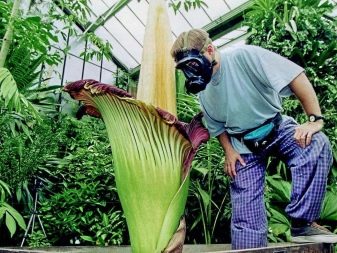
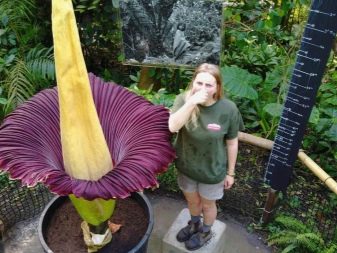
Types of amorphophallus
The genus amorphophallus includes about 100 species of perennial and annual tuberous grasses.
- Amorphophallus giant is the largest plant of this genus. Reaches a height of 2 to 5 meters. During flowering, it heats up significantly, and it is during this period that an extremely unpleasant odor emanates from it. An interesting feature of this plant is that before rain or after watering, drops of water hang on the tips of the cut leaf. Amorphophallus giant tubers reach 40 kg with a diameter of about 50 cm. This exotic giant plant does not occur in indoor culture.
- Amorphophallus of the Riviera also differs in considerable size, but no longer inflorescences. His petiole reaches a height of 1.5 meters, and a leaf grows one meter wide.
- Amorphophallus cognac (A. konjac) is one of the most common species in indoor culture. The ear of the inflorescence greatly extends beyond its veil and reaches 50 cm. The name of the species is given by the name of the Japanese national dish made from the tubers of the plant - cognac.
- Amorphophallus bulbiferous (A. bulbifer) - also often found at home. The ear does not go beyond the bedspread. The species differs in that a nodule is laid at the base of the leaf during its growth, which, when the leaf dies off, can be used to obtain a new plant.
- The dwarf or pygmy species of amorphophallus is an excellent culture for growing at home. The plant, even in its natural environment, grows no more than 50 cm. The cover and the cob are white with a golden tint. The upper part of the inflorescence is pointed and irregular in shape.

Planting tubers
The tubers of this plant usually start selling in the winter. Purchased bulbs should be stored in the refrigerator until spring at a comfortable temperature of +10. Plant in March.
In order for the plant to grow actively, it is necessary to choose the right pot, focusing on the weight, type and size of the tuber. A narrow container will interfere with root development. An insufficiently deep capacity can provoke rotting of the root system or its deformation. Large tubers need a spacious container, and shallow containers are used for planting bulbs and babies. At the bottom of the pot, a powerful drainage layer is required (pieces of steamed bark or expanded clay).It will prevent the root from rotting, and will also facilitate the removal of excess moisture.
On indoor amorphophallus, the development of the root system begins at the top of the tuber. Therefore, when planting, the bulb must be significantly deepened, while placing it horizontally. Growth occurs rather quickly, and only when a leaf or a top of a flower appears above the surface of the soil, it slows down.
Planting, reproduction and care
For reproduction, seeds, tubers and children are used. The easiest way is reproduction by children, which is formed on the mother's tuber before the dormant period begins.
You can also split a tuber that has already awakened after winter and has thrown out some shoots. Places of cuts are covered with crushed coal, allowed to dry for a day and transplanted (Figure 6).
Seed propagation is rarely practiced, since under artificial conditions, adult crops practically do not bear fruit, and with this method of propagation, a full-fledged plant can be obtained only after 7 years.
Figure 6. Reproduction and planting of culture
In terms of care, amorphophallus belongs to crops with an average demand.
The main stages of plant care include:
The lighting should be bright enough, as this inhabitant of the tropics normally tolerates exposure to direct sunlight. In winter, when there is not enough natural light, phytolamps are used to extend daylight hours.
The temperature during the flowering period should be room temperature, but it does not make sense to regulate it artificially, since the crops normally tolerate both high and relatively low temperatures for summer. After the aerial part has dried out, the flower pot must be transferred to a cool place with a temperature not higher than +13 degrees.
The moisture content of the plant needs to be high enough. To maintain it, the leaves are sprayed daily with water, but during the flowering period it is better to replace this procedure with a stationary humidifier. The fact is that drops of water, falling on the inflorescence, cause it to quickly dry out.
Watering is carried out often, and begins immediately after the appearance of the first shoots.
In this case, it is important not to allow the accumulation of excess liquid in the pot in order to prevent the bulb from rotting. Water along the edge of the pot so that the water is evenly distributed over the soil and does not accumulate over the tuber
All excess water from the pan is immediately removed.
In general, caring for amorphophallus is not difficult, and the unusual shape of the plant itself and its inflorescences will serve as a real decoration for your home and garden.
Subtleties of home care
Caring for amorphophallus in pot growing is simple and consists in timely watering and feeding, providing slightly increased air humidity and the correct organization of the dormant period.
Watering and feeding
From the moment the sprout appears and until the leaf turns yellow, amorphophallus is watered regularly, trying to avoid water getting on the tuber. You can use bottom watering - place the pot in a container with settled water for 20 minutes. During this time, the soil will be moistened, the pot can be pulled out, allowed to drain and placed on a pallet. With the beginning of wilting of the leaf, watering must be reduced and watered only as the earthen coma dries up.
For flowering, amorphophallus needs regular feeding. Fertilizers can be applied after a sprout appears or after rooting, if a transplant was carried out. Amorphophallus needs an increased phosphorus content for flowering, therefore, once every two weeks, Agricola can be applied in liquid form for flowering plants. In this preparation, trace elements are contained in proportions most suitable for corm flowers. To increase the phosphorus content, you can add double superphosphate to the Agricola solution (for 3 liters of water, 1 teaspoon of Agricola and 1 teaspoon of double superphosphate). It is advisable to alternate mineral dressings with organic ones.Liquid universal fertilizer Ideal, due to its high phosphorus content, is quite a suitable option for amorphophallus.
Amorphophallus flowering period
If all growing conditions are met, amorphophallus blooms, as a rule, in March. Flowering lasts two weeks, after which the wilted flower can be cut off. A short rest period begins. At this time, the tuber replenishes the energy spent on flowering and prepares to continue its growth. At this time, watering is slightly reduced, and they begin to feed with the appearance of a leaf.
Dormant period
A very important condition for the flowering of amorphophallus is the dormant period. It begins after wilting of the leaf and lasts about six months. At this time, the pot with the tuber must be removed to a cool (+ 10–14 ° C), shaded place. Watering is stopped, you can only occasionally moisten the ground a little. Some growers, after wilting, remove the tuber from the soil, clean it, cut off the rotten parts, dusting the cuts with crushed coal, and process them in a pink solution of potassium permanganate. A slightly dried tuber is covered with dry calcined sand or wrapped in paper and stored in a cool place until spring.
Care errors
| External manifestation of errors | Cause of occurrence | Elimination method |
| The tips of the leaf dry out | Insufficient air humidity |
|
| Brown spots appear on the leaf plate | Lack of micronutrients | Arrange the application of dressings |
| Rotting tuber | Perhaps due to overflow | Water the amorphophallus gently, along the edge of the pot, avoiding water getting on the tuber |
Breeding features

Amorphophallus is most often propagated by nodules or bulbs (in amorophallus bulbous), growing on the mother tuber. They can be separated when the plant is dormant. Rinse the separated nodules, dip in a pink solution of potassium permanganate for a few minutes, dry and store.
Store them, as already described, in slightly damp sand or wrapped in paper, at a temperature of 10-13 ° C until spring. In March, when sprouts appear, plant in pots. If the main tuber remains in the ground for the winter, then the nodules can be separated in the spring. Similar actions are carried out with onions.
Reproduction is sometimes used by dividing the tuber. In the spring, during awakening, the tuber is cut into pieces according to the number of shoots. Sections are powdered with crushed charcoal, dried in air for several hours and planted in the usual way. It is necessary to cut the tuber with a sharp, clean knife, being careful not to touch the sprout.
Amorphophallus is the same flower for an amateur. If you like unusual plants, and this friend is unusual in everything, if it gives you pleasure to watch the development of a curiosity and is not afraid of the prospect of sipping the eerie scents of a blooming beauty, then amorphophallus is undoubtedly your flower! Feel free to plant and, given its undemanding conditions, you will certainly wait for flowering.
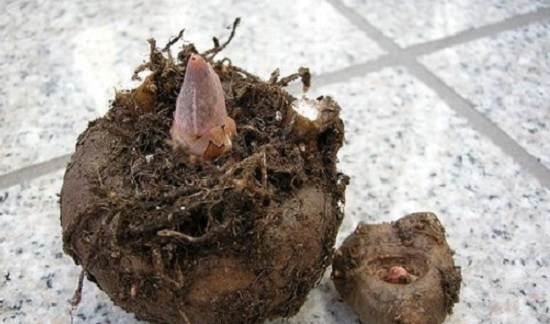 Sometimes in the process of transplanting in a pot with amorphophallus, you can find a pleasant surprise.
Sometimes in the process of transplanting in a pot with amorphophallus, you can find a pleasant surprise.
Breeding process:
- In the fall, before the onset of the dormant period, remove the flower from the ground and sift the soil in search of "offspring". Their storage conditions in winter do not differ from those provided for adult tubers.
- In the spring, plant young amorphophallus in containers of suitable size. The substrate and further care are standard.
- If there are no “offspring”, cut the tuber with a sharp disinfected knife so that each of the parts has at least one growth point. Sprinkle the slices with crushed activated carbon. Leave the planting material outdoors for about a day.
- The next day, plant the tuber pieces in a substrate suitable for amorphophallus, water very sparingly. Maintain a constant temperature of about 22-24 ° C and bright, diffused light.It is not necessary to cover the planting, creating a greenhouse effect, so as not to provoke the development of rot.
This is not to say that amorphophallus forms daughter tubers very readily. Even under optimal conditions, no more than two “offspring” appear per season. The flowering of new plants will have to wait at least five years. During this time, the tuber will accumulate enough nutrients and increase in diameter up to 5–30 cm.
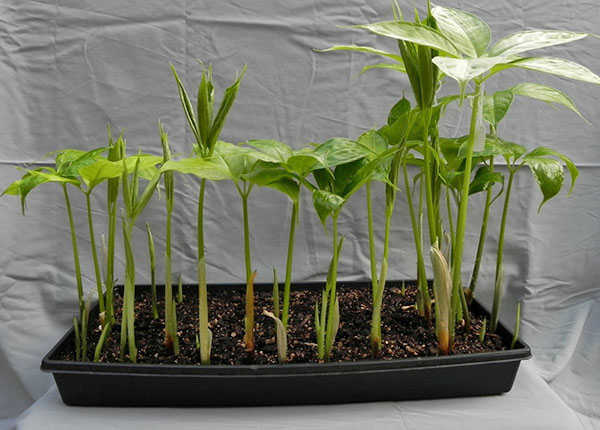 Amorphophallus grows rather slowly, but every year the dimensions of the leaf necessarily increase
Amorphophallus grows rather slowly, but every year the dimensions of the leaf necessarily increase
Reproduction of amorphophallus is possible in various ways.
Germinating seeds
Palm trees are rarely grown from seeds, since this is a very laborious and long-lasting process. And the plant will be able to bloom no earlier than in five years. If such a desire still arises, a step-by-step recipe for germinating seeds will look something like this:
- Soak the seeds for a couple of days.
- Mix garden soil, peat and vermiculite.
- Place the seeds in the soil mixture to a depth of 7 to 12 mm.
- Place the container with seeds in a warm and well-lit place.
Seedlings can be expected on average in ten days, in another week the seedlings will give the first leaf.
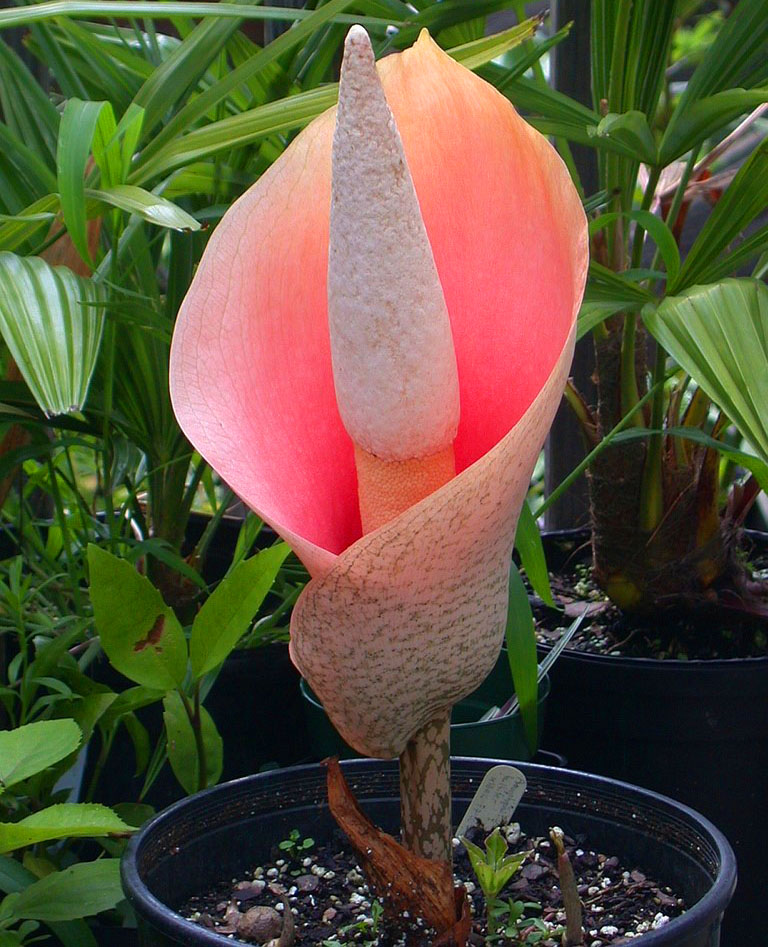
The bulbous variety is often grown in artificial conditions.
You should not rush to transplant the sprouted sprouts into separate containers, many of them will die as they grow.
Dividing the bulb
Daughter tubers when transplanting is simple and reliable. True, the "youth" will not bloom. First, the tubers must grow and gain mass, which takes 5 to 10 years.
Seed reproduction in an apartment is practically impossible, unless you get seeds. In order for seeds to set in indoor amorphophallus, at least two plants must bloom at the same time.
But flowering without fertilization will not harm the plant and you can not fear for the life of your pet.
Amorphophallus: transplant and planting
Both the transplant and the planting of the amorphophallus are performed during the rest period. The tuber is planted when young shoots appear. As a rule, this occurs in the third decade of February or early spring.
The tuber is planted in a pot that is twice the size of the tuber. In order for the formation and development of the root system to proceed normally, a deep container should be chosen. A drain is placed at the bottom of the pot. It should take 2-3 cm. It can be expanded clay, chipped brick or pebbles. The acidity of the soil should be weak or neutral.
To plant a houseplant you need:
- Cover drainage with a layer of 2-3 cm.
- Place the tuber in the pot with the groves facing up.
- Sprinkle with soil so that the sprouts are above the ground, and about 7-8 cm to the edge of the pot.
- Compact the soil a little.
- Gently pour over the tuber with soft and settled water. Care should be taken not to get water on the tuber itself.
- Place the pot in a well-lit place, but not in direct sunlight.
The peculiarity of the amorphophallus tuber in the formation of a thickening of the stem in the seedling, the next year a leaf appears on this tuber and a new tuber is immediately formed, larger, and the first does not separate. With age, quite a lot of daughter tubers (children) are formed. Reproduction by children (this operation is done in the fall): after the leaf dies off, the tuber is removed from the pot, the children are collected and stored until spring in a bag with slightly moistened peat (when squeezed in the hand, it should crumble). A bag with children is tied and placed in a cool place. In the spring, children are planted in soil mixture.
The main varieties of the plant
In the apartment you can find two varieties: amorphophallus cognac and amorphophallus bulbous.
Amorphophallus cognac
This type of flower is more common. The plant has one leaf plate. Its second name is amorphophallus river. It has a bright red or burgundy flower that looks like calla lilies. Flowering period: 14 days, usually in March or April.In September, the aboveground part of the plant dies off, and the flower goes into a dormant state.
When grown in an apartment, amorphophallus can reach a height of 80 centimeters. Its leaves resemble an umbrella in shape. In autumn, they die off; in the next season, the leaf plate becomes larger. Drops appear on the leaf plate before the rain. Many children are formed on the rhizome of the plant, so it multiplies easily.
It is used in cooking for the preparation of side dishes and soups, and spices are made from it. This variety is actively used to treat obesity, lower blood sugar and cholesterol levels.
Amorphophallus bulbous
Height: about a meter. It is characterized by an onion-shaped seal that grows under the leaf plate. At home, the fruits of this variety do not ripen. The amorphophallus bulbous flower reaches a length of 30 centimeters and has a pink tint. In this variety, the color of the leaves resembles light camouflage with dark spots.
Titanium
This name amorphophallus is due to its enormous size, for this reason it can only be seen in the wild or in greenhouses. But in the natural environment, its number is very small. The last flower of the titanic variety was discovered in Sumatra in 1993. The size of a huge burgundy flower exceeds three meters, and the weight of the inflorescence reaches 70 kilograms.
Peony-leaved
This type of plant is similar to the titanic variety, but is smaller in size. In a natural environment, it can reach two meters. Its development cycle is the same as that of the cognac variety.
Types for indoor cultivation
Amorphophallus cognac (synonym A. Rivier)
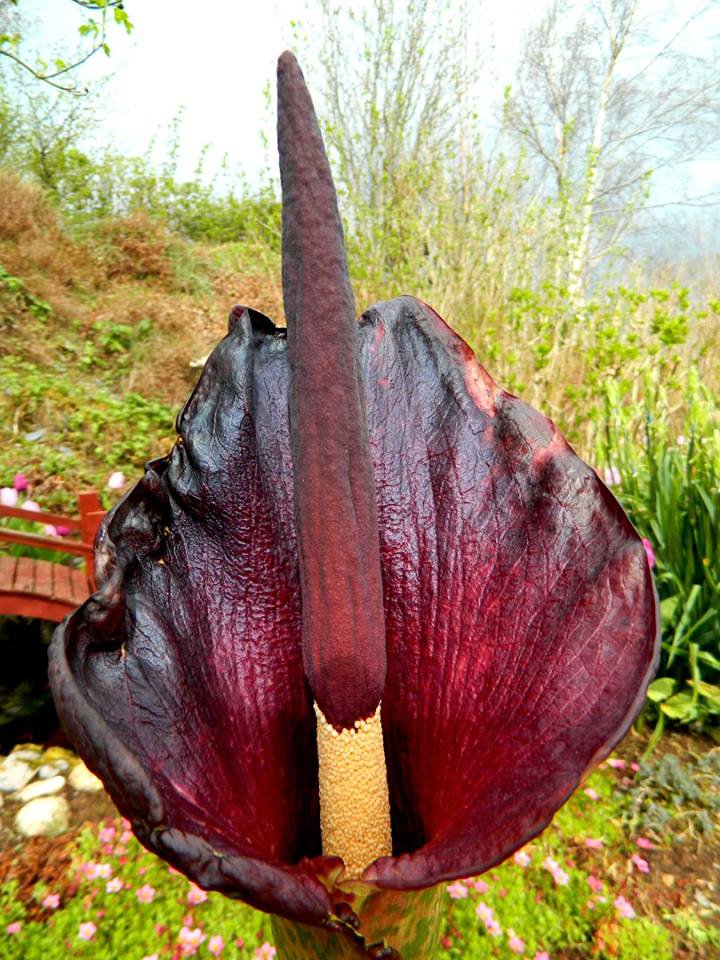
It has several "poetic" names: the tongue of the devil, the palm of the snake, the lily of Voodoo. Homeland of the species monsoon forests of southern China and South Vietnam. Cultivated as a food plant from Japan and China to Indonesia.
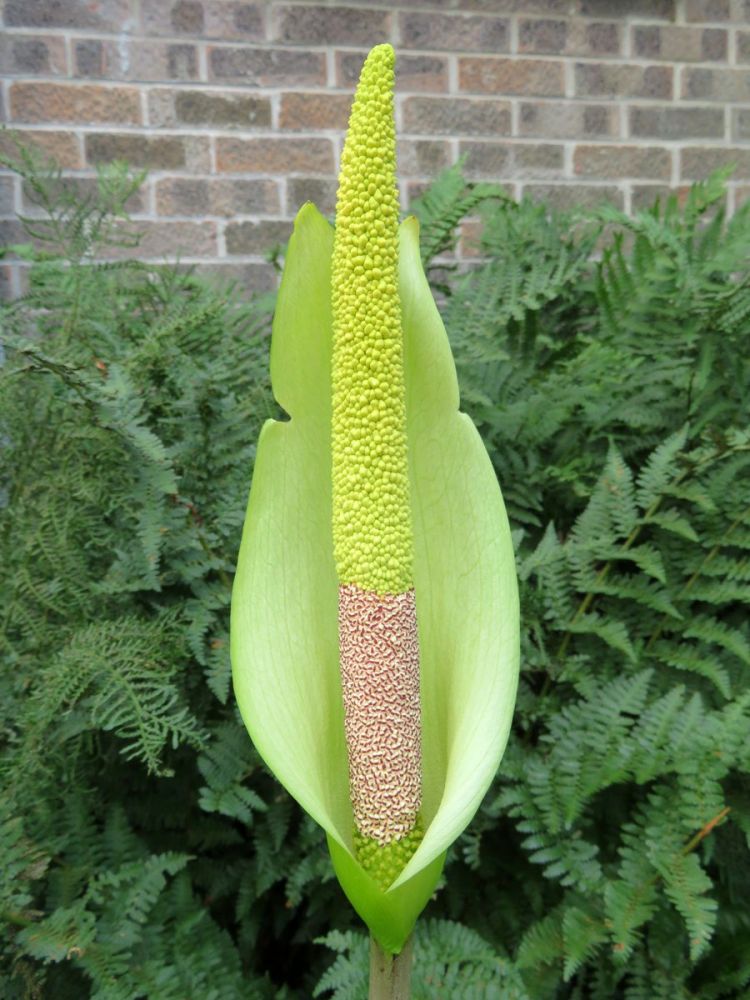
The tubers have the shape of a flattened ball, can reach a diameter of 25-30 cm. The inflorescence is black-violet, the ear is up to a meter long, the cover is shorter, cherry or burgundy, lighter outside. Flowering lasts about two weeks and it is truly a fantastic sight.
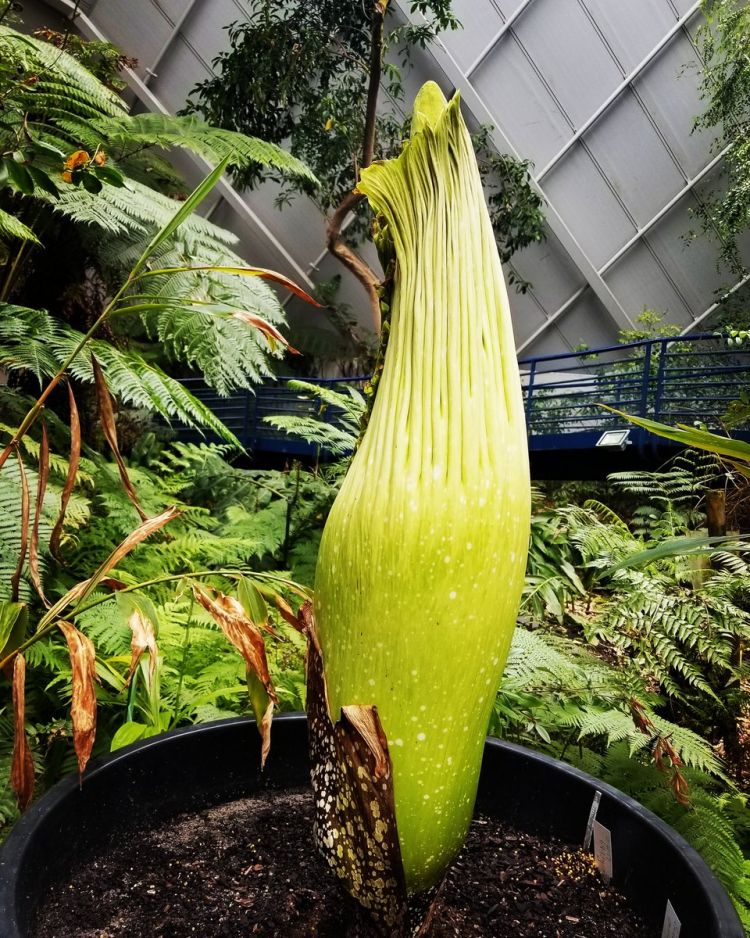
But there is a problem - the flower exudes a scent that is attractive to flies, but not to the human sense of smell. What is the smell of blooming amorophallus not compared to?

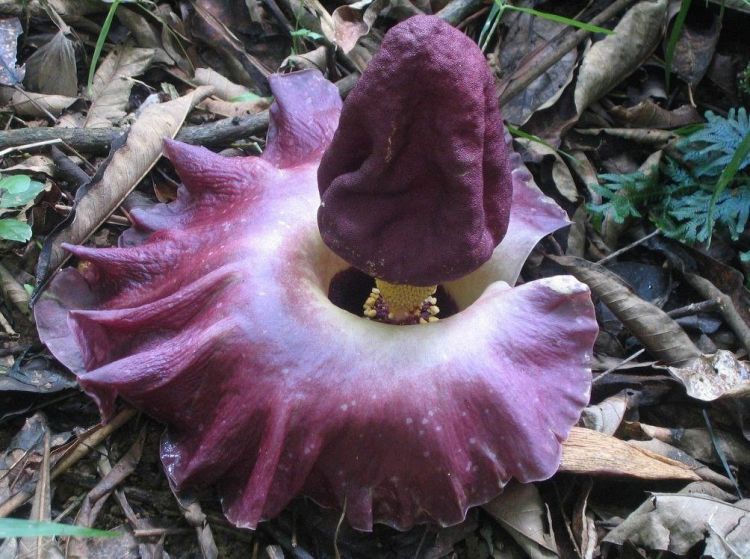
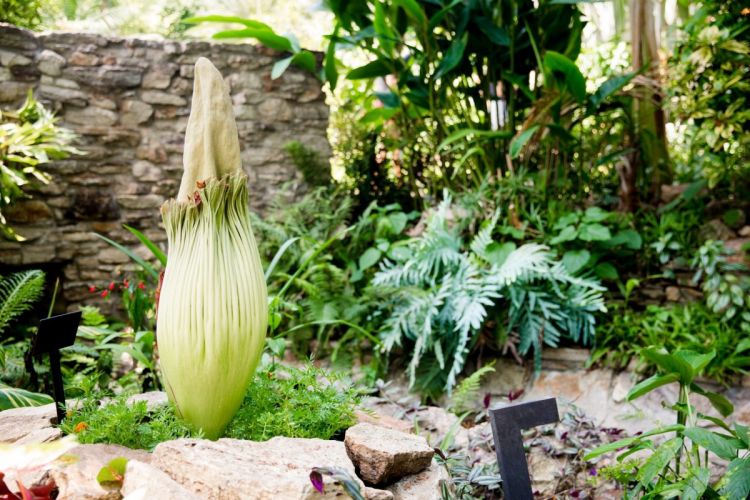
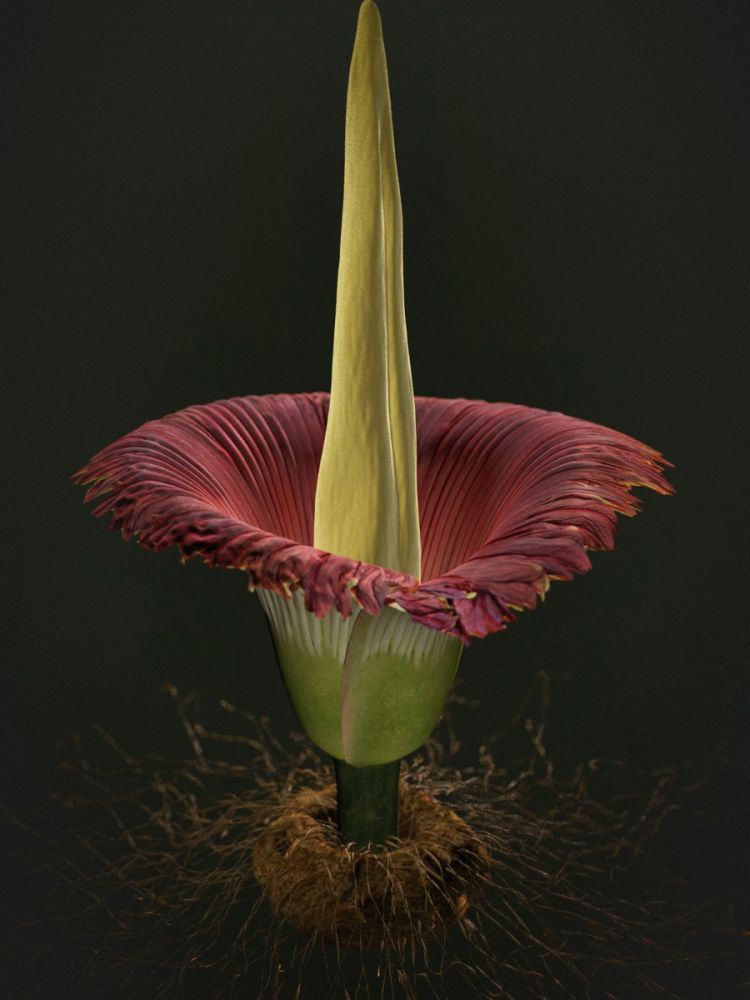
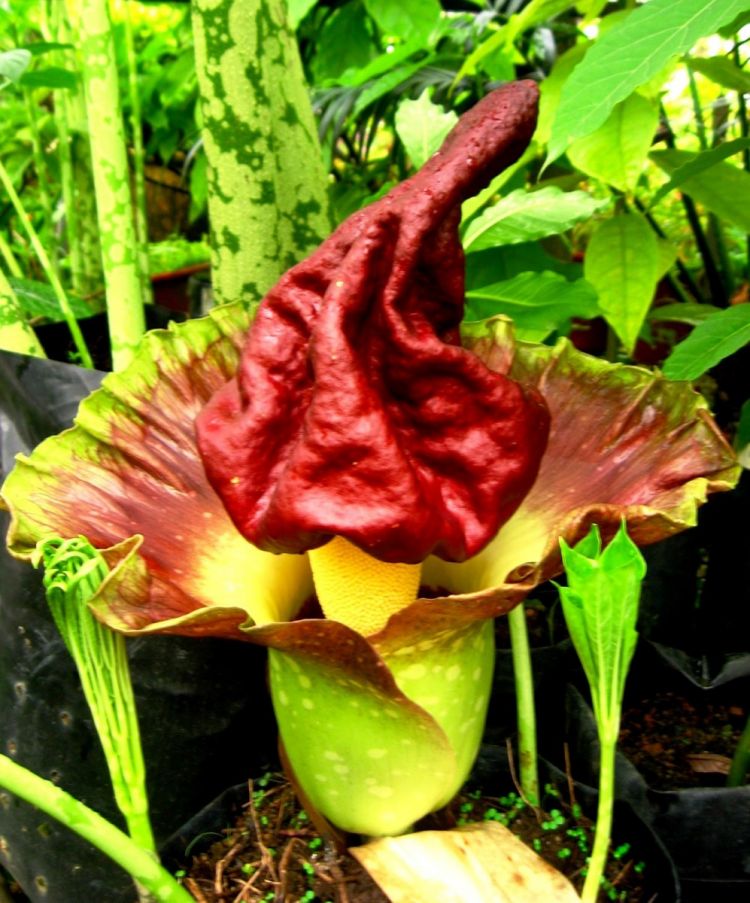
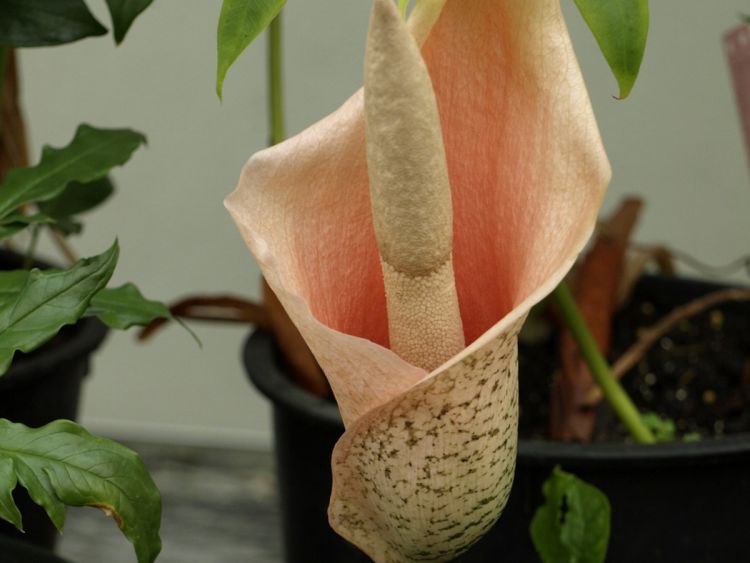
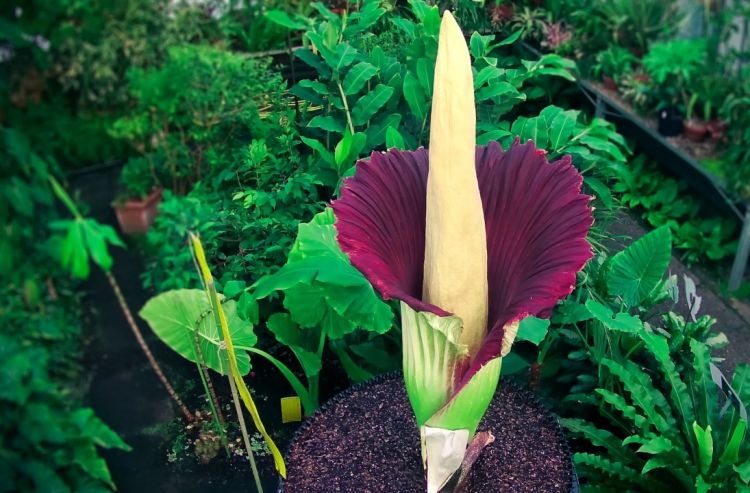
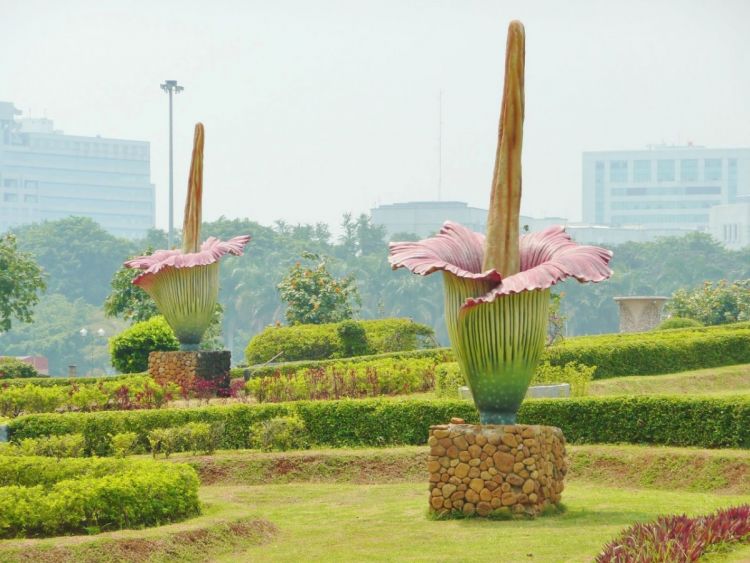
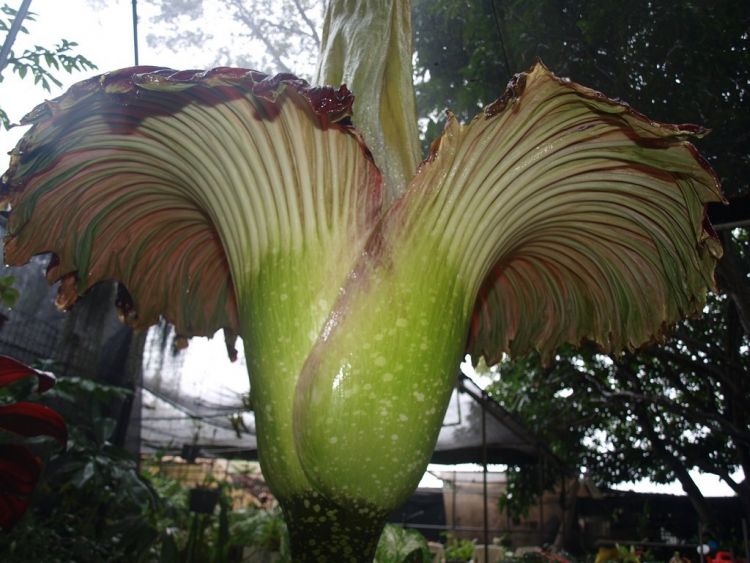
For some it is a mixture of rotten meat with rotten fish and dirty socks, for others it is a mouse corpse, a mixture of rotten eggs and fish, or even the smell of a barnyard and dirty diapers.
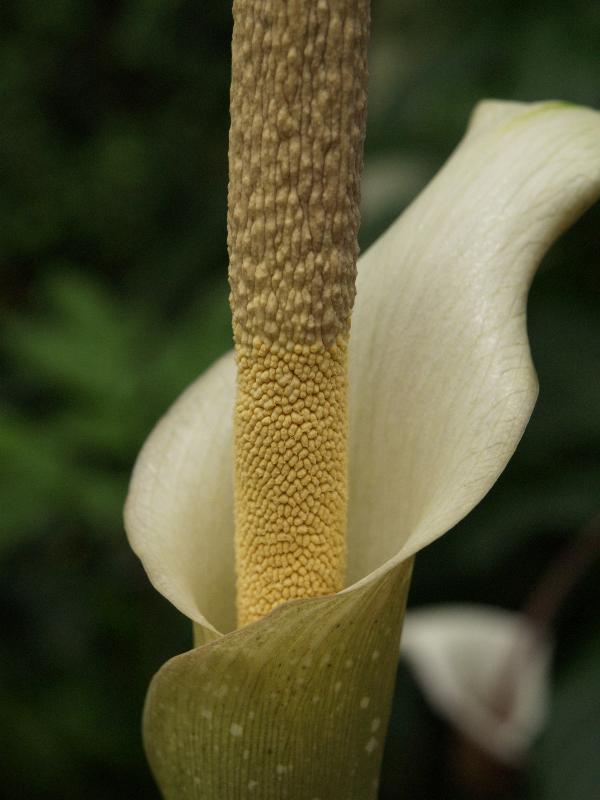
As a consolation, we can only say one thing: this is exactly the case when beauty requires sacrifice!
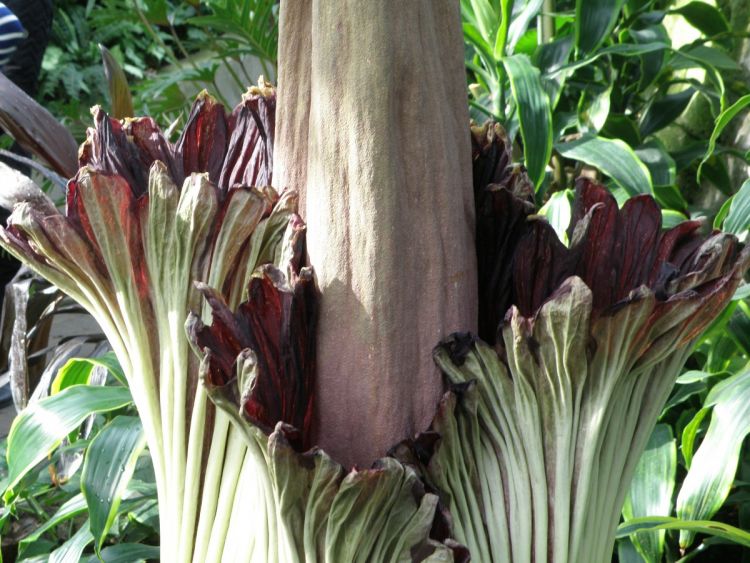
If you want to admire the amorphophallus flower, you will have to endure. However, the strong smell lasts no longer than three days: it appears when blooming, gradually intensifies, reaches a peak on the second day and is practically not felt by the end of the third day.

One leaf, on a long petiole, reaches a height of 1 meter. The leaf plate in an adult plant can be up to 2 m in diameter and looks like a crown of a tree or a huge open umbrella.


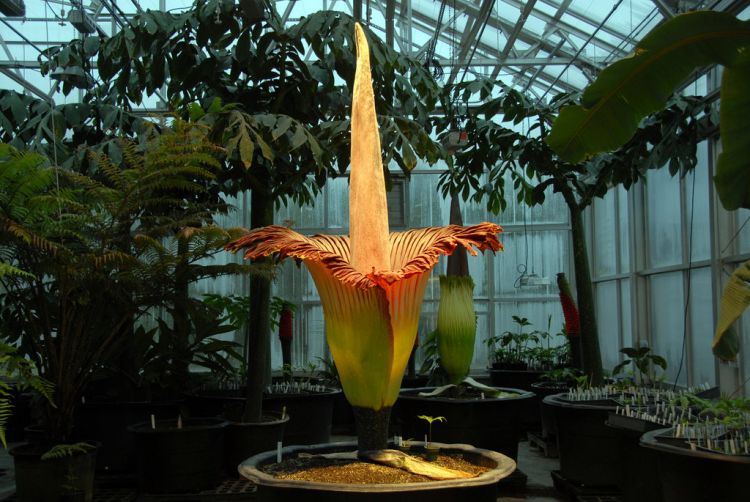
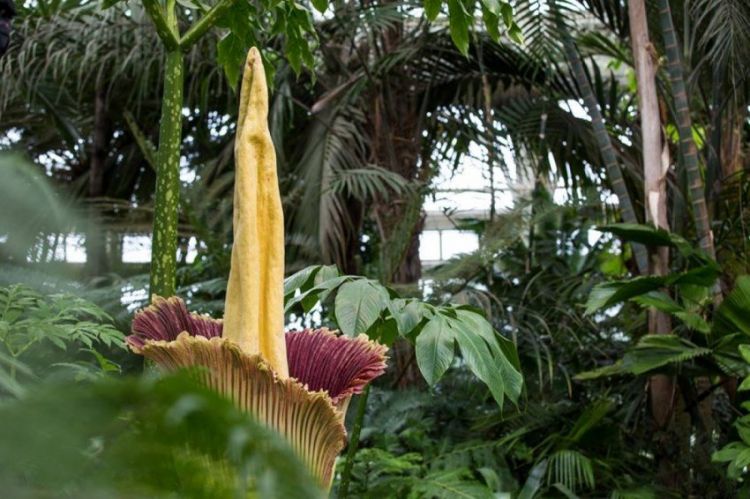
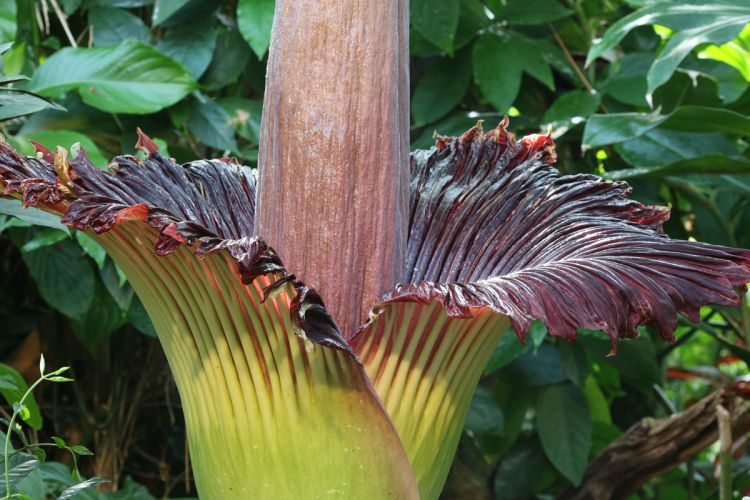

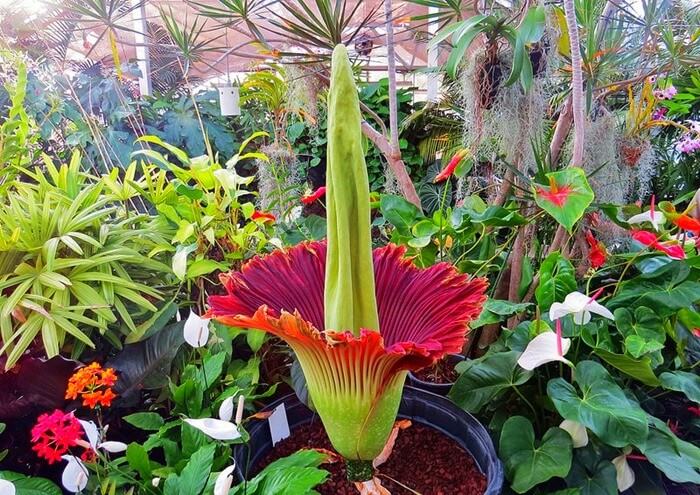
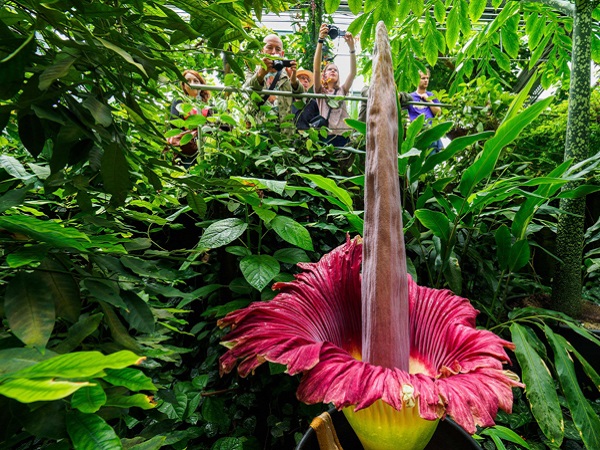
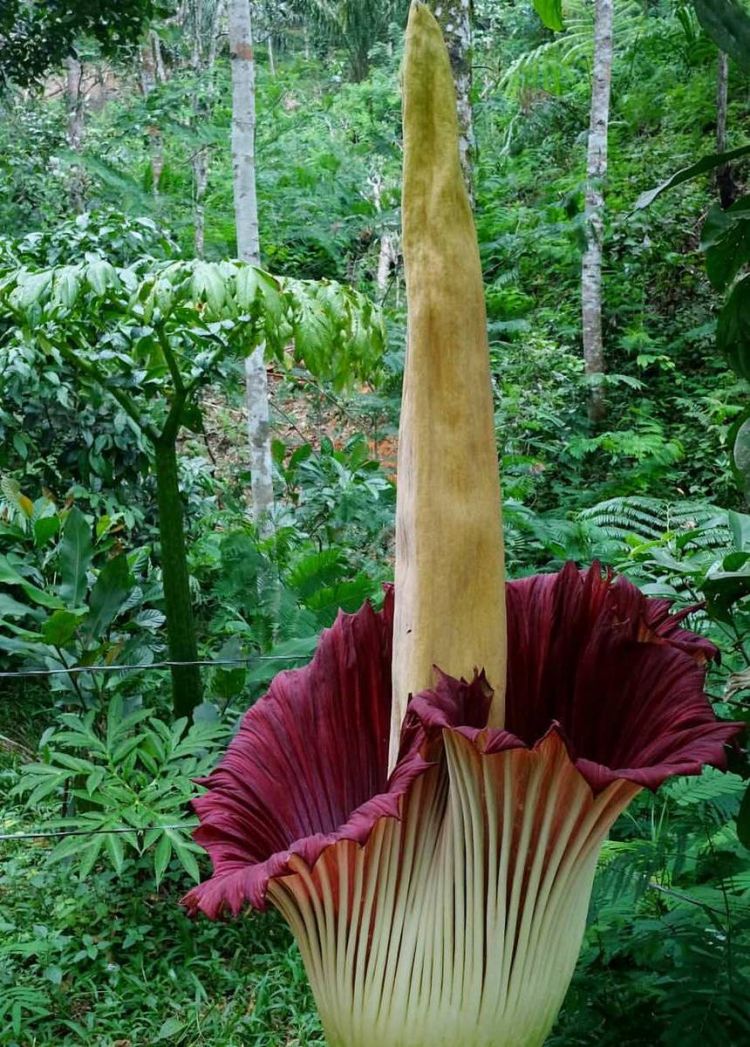
Types of amorphophallus grown at home:
- Amorphophallus bulbifer has only one leaf on the petiole, the color of which is dark olive with light spots. The petiole is about 1 meter long and the leaf is divided into segments. The peduncle is usually about 30 cm long, and the color is dirty green with pinkish spots.
- Amorphophallus Cognac (Amorphophallus konjac \ rivieri) has numerous juicy green leaves, leaf petioles of dark olive color with dark and light spots. If the plant does not have enough light, the color of the leaf changes its color - it becomes more contrasting, dark green with red edges. It blooms in burgundy or purple-red. In China, Amorphophallus Cognac has been cultivated for 1500 years because of the tubers, which are used as a dietary product that lowers cholesterol and blood sugar, and in Japan, the tubers of this plant are used to make soups, flour, and tofu. In their opinion, they help to reduce weight and cleanse the gastrointestinal tract from toxins. In medicine, products for diabetics are made from the tubers of Amorphophallus Cognac. It is rarely grown at home, since it is large enough.The leaf petiole reaches 80 cm and has a pattern of white and brown spots, and the leaf plate can reach 1 meter in diameter, pinnately dissected. During flowering, the peduncle grows up to 1 meter high, the flower cover is 30 cm long, and the ear is twice as long as the cover.
- Amorphophallus Titanic (titanum) is considered the largest flower in the world, which not only has a huge flowering, but also a tuber, which can reach up to half a meter in size and weighing 23 kg. This giant of the herbaceous world was discovered by a botanist from Italy, Odorado Bekkeri, who found it in the tropical forest of Sumatra. Subsequently, many botanical gardens of the world began to grow this miracle flower, luring more and more visitors who want to gaze at the inflorescence as tall as a person, or even more than 2 meters. The ear of this huge flower rises almost 1.5 meters above the bedspread, and during flowering it heats up to 40 ° C, spreading the stench of rotten meat.
Amorphophallus: species
The genus amorphophallus includes over 100 species, but only a few of them are unusual and popular among modern florists.
Amorphophallus bulbifer
A plant with one leaf, reaching 1.5 meters in length. At the very base of the plate and at the top of the petiole, small tubers are formed. The petal (cover) of amorphophallus bulbous reaches 20 cm in length, has a greenish color interspersed with pink spots, inside it is greenish-yellow, and red at the base. The inflorescence stem grows 30 centimeters in height. This type of amorphophallus grows in the monsoon forests of East India and Burma.
 Amorphophallus bulbous
Amorphophallus bulbous
Amorphophallus cognac (Amorphophallus konjac)
Corm plant with one single leaf up to 1 m in height (appears after flowering), peduncle 70 cm in height, its inflorescence consists of an ear and a cover, which is twice as long as an ear in size. It is used as an ornamental one despite the disgusting odor emitted by the plant during flowering.
 Amorphophallus cognac
Amorphophallus cognac
Amorphophallus campanulatus (Amorphophallus campanulatus)
A plant with rounded tubers up to 30 cm in diameter. Has tripartite leaves. The petal is almost four times as long as the stem and is purple-violet. The homeland of amorphophallus bell-shaped is Fiji, New Guinea, the Philippines, Sri Lanka.
 Amorphophallus campaniform
Amorphophallus campaniform
Amorphophallus Rivera (Amorphophallus rivieri Durieu)
A plant with large tubers (up to 30 cm in diameter). A single wide-umbilical leaf reaches 1 meter in length. The plant has a green petiole with a whitish or brownish pattern. The bedspread is 30 cm long, glossy, tubular at the base, dark purple in color. In the upper part, the inflorescence grows up to 30 cm in length, has a rich black-purple color. Amorphophallus Rivera blooms, but rarely bears fruit.
 Amorphophallus river
Amorphophallus river
Amorphophallus titanium (Amorphophallus titanum)
The tubers of this plant are impressive in size - up to 50 cm in diameter and weigh up to 23 kilograms. Its leaf is huge, up to 3 meters in diameter, fork-pinnate, tripartite. The petiole is up to 5 meters long and 10 cm thick, has a dull green color with a small number of white transverse stripes.
 Amorphophallus titanium
Amorphophallus titanium
Petal 70-80 cm long, green outside, brown-purple inside. Grows in the monsoon forests of Sumatra. This exotic plant of gigantic size does not occur in indoor culture.

